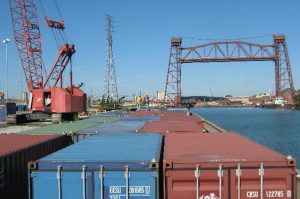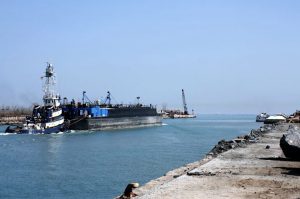Hotel, marina planned for ‘underused’ Chicago port district
By Jean Lotus Staff Reporter — March 13, 2017
Shipping containers sit in barges docked at the Illinois International Port District. (Photo courtesy of IIPD website)
The Illinois International Port District — a gritty shipyard visible from the Bishop Ford Freeway — is trying to become less of a backwater, said the district’s executive director. A hotel, marina and outreach to industry and nearby community groups are part of the vision for the port district’s two sites in Lake Calumet and at Iroquois landing, also called the “Port of Chicago.”
“We’re the only port that has access to the Great Lakes that is also a river port with access to the Mississippi River and the Gulf of Mexico,” said Clayton Harris III at a March 8 presentation at the University of Illinois Chicago Great Cites Institute. “That means we are open year-round,” he said.
Harris, who started at the port last year, said the port’s proposed hotel, awaiting a request for proposals from the board, will take advantage of proximity to the neighboring Pullman National Historic District and provide up to 250 jobs. The port property already contains the privately-run Harborside International public golf course. A marina would follow, Harris said.
The port district owns two parcels of land dredged to 27 feet depth to accommodate sea-faring commercial vessels from the Great Lakes. The Iroquois Landing Terminal sits at the mouth of the Calumet River at Lake Michigan. The Lake Calumet docks and warehouses sit six miles inland near marshy areas in the elbow of the Calumet River.
Chicago and the region are missing out on the underused potential of waterway transportation, which is the cheapest form of transportation if time is not an issue, Harris said. “What people recognize is, we can do more.”
Created by the Illinois General Assembly in 1951, the port district is a freestanding municipal corporation, earning revenue from land leases, renting transit sheds and warehouses and from dockage and wharfage fees. About 25 tenants, including sugar, cement and steel companies rent space on the port, as well as a stevedore company and the Chicago Marine Fire Department and the Chicago Fire Air Sea and Rescue agency. Several rail lines terminate at the port.
The IIPD has been losing money past several years, with 2015 revenues of $3.4 million, down from $7.9 million in 2012, according to annual financial reports. Efforts to privatize the port in 2013 and 2015 were unsuccessful. The port district is controlled by a board of trustees, with five members nominated by the Governor and four nominated by the Mayor of Chicago. The port is designated a foreign trade zone, or “free trade zone” where commercial merchandise, domestic and foreign, may be stored and exported from the zone without paying duty or excise tax, according to the U.S. Customs and Border Protection.
The first step is letting people know the port exists, he said. “I went to Washington D.C., I went to Springfield and they say, ‘Chicago has a port?’”
He’s looking for industrial partners to lease warehouses and perhaps assemble parts imported by water transit on-site, he said. “We’re trying to find the right industrial partners and catch lightning in a bottle.” Modernizing the port will take time, Harris said, because the district is carrying too much debt to float bonds. Eventually, the port would like to own its own crane and a boat down the road, he said.
Massive container ships now passing through the widened Panama Canal are going to mean big opportunities for the Midwest, said IIPD Trustee Paul Chialdikas, appointed by Gov. Bruce Rauner in 2015.
“In the past, [shipping goods by water] has focused on the east and west coasts,” Chialdikas said. “With the wider Panama Canal, larger vessels will pulling into Galveston, Texas, and the country will be divided in half. That distribution becomes a big opportunity for the Midwest. A company can ship to St. Luis, which is half-way up the Mississippi and then [transport goods] west or east. That’s why it’s so exciting,” Chialdikas said.
Chialdikas is also a trustee for the Village of Lemont, which hosts several barge shipping businesses along the bedrock banks of the Sanitary and Ship Canal and the Cal-Sag Channel.

A tugboat pushes a barge into Lake Michigan past the Iroquois Landing Terminal at the mouth of the Calumet River. (Photo courtesy of IIPD website)
Local Lemont barge companies have developed a niche pushing barge traffic from the Mississippi river through the locks-system of lakes, rivers and canals of the trans-state Illinois Waterway, Chialdikas said. Boats use special retractable pilothouses to duck under low-level railway bridges, starting with the Santa Fe line bridge just East of Lemont road. Chialdikas believes barge technology will continue to evolve to accommodate container shipping.
But industry isn’t the only focus of the port district, Harris said. The port is looking at recreation opportunities for neighbors, such as a bike path connecting the Pullman neighborhood to a BMX bike park opened at the Big Marsh area at 116th Street and Stony Island Avenue. Harris said the port district was planning outreach events, like a 10K race and a golfing event to come to the attention of residents from Pullman, Hegewisch and Altgeld Gardens. Along with visibility, Harris believes the port can eventually bring jobs and economic development to depressed blue-collar neighborhoods. A summer student program restoring pontoon boats is in the works, he said.
The port district is also part of a Lake Calumet wetlands ecological zone that hosts bald eagle nests and other wildlife, Harris said. The area has been called the “Natural Capital of the Southern Lake Michigan Coastal Zone” by the Illinois Dept. of Natural Resources.
“Economic development, recreation, industry and conservation and community,” Harris said. “We can coexist if we do it correctly.”
Free subscription to the digital edition of the Cook County Chronicle
Read the current issue of the Cook County Chronicle
— Hotel part of marina planned for ‘underused’ Chicago port district —







